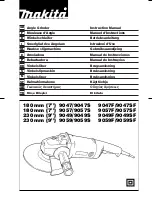
12
8.3
Tool Rest
As the wheel wears down, the tool rest must be re-
adjusted to maintain a maximum 1/16" distance.
Refer to Figure 8-1.
1. Loosen two hex cap screws (C
1
).
2. Slide tool rest (C
2
) to within 1/16" from grinding
wheel.
3. Tighten screws (C
1
).
9.0
User-maintenance
For safety, turn switch to OFF and remove plug from
power source outlet before adjusting or performing
maintenance on the bench grinder.
If the power cord is worn, cut or damaged in any
way, have it replaced immediately.
9.1
Ring Test
Before replacing a grinding wheel, perform this
simple test on the replacement wheel:
1. Loop a piece of string through the grinding
wheel hole and suspend the wheel by holding
up the string.
2. Tap the wheel with a piece of scrap wood or
wooden dowel.
3. A good wheel will "ring"; a defective wheel will
"thud". Discard any wheel that does not "ring".
An internal defect may not be apparent by visual
inspection alone. The ring test may identify an
internal crack or void.
9.2
Care of Grinding Wheels
In normal use, grinding wheels may become
cracked, grooved, rounded at the edges, chipped,
out of true or loaded with foreign material.
A
cracked
wheel
should
be
replaced
IMMEDIATELY. The other conditions can be
remedied with a dressing tool. New wheels
sometimes require dressing to make them round.
See
sect. 9.5.
9.3
Changing Wheels
The JET bench grinder comes equipped with a
general purpose grinding wheel. Wheels vary
according to types of abrasive, hardness, grit size,
and structure. Contact your local distributor for the
proper grinding wheel or wire wheel for your
application.
If you replace a wheel, obtain one with a safe rated
speed at least as high as the
NO
LOAD RPM
marked on the grinder's nameplate. Refer to Table
3 to determine correct dimensions for the
replacement wheel.
Model
Wheel
Diameter
Maximum
Width
Center
Hole
JBG-6W
6"
3/4"
1/2"
JBG-8W
8"
1"
5/8"
Table 3
Your bench grinder will accept most polishing and
buffing wheels available at dealers and hardware
stores.
The use of any other accessory
is not recommended and may result in serious
injury!
To change a wheel
(see Figure 9-1)
:
1. Disconnect grinder from power source.
2. Loosen spark guard (A) and tool rest (B) and
move them away from wheel.
3. Remove wheel guard using a screwdriver.
4. Stabilize wheel by holding opposite wheel
firmly, or placing a wood wedge between wheel
and tool rest.
5. Unscrew arbor nut (C) with wrench.
NOTE
: Left
wheel nut has left-hand threads; turn nut
clockwise
to loosen. Right wire wheel nut has
right-hand threads; turn nut counterclockwise to
loosen.
6. Remove outer flange (D), wheel (E), and inner
flange.
7. Clean flanges. Check the flanges to make sure
they are flat. Wheel flanges that are not flat will
cause the wheel to wobble.
Figure 9-1: wheel replacement










































